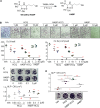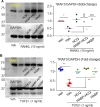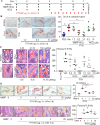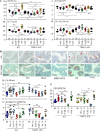This is a preprint.
Hydroxychloroquine and a low activity bisphosphonate conjugate prevent and reverse ovariectomy-induced bone loss in mice through dual antiresorptive and anabolic effects
- PMID: 38746138
- PMCID: PMC11092802
- DOI: 10.21203/rs.3.rs-4237258/v1
Hydroxychloroquine and a low activity bisphosphonate conjugate prevent and reverse ovariectomy-induced bone loss in mice through dual antiresorptive and anabolic effects
Update in
-
Hydroxychloroquine and a low antiresorptive activity bisphosphonate conjugate prevent and reverse ovariectomy-induced bone loss in mice through dual antiresorptive and anabolic effects.Bone Res. 2024 Sep 5;12(1):52. doi: 10.1038/s41413-024-00352-6. Bone Res. 2024. PMID: 39231935 Free PMC article.
Abstract
Osteoporosis is incurable because there are no dual antiresorptive and anabolic therapeutic agents that can be administered long-term. The most widely used antiresorptive agents, bisphosphonates (BPs), also inhibit bone formation and thus have limited effect in preventing osteoporotic fracture. Hydroxychloroquine (HCQ), which is used to treat rheumatoid arthritis, prevents the lysosomal degradation of TNF receptor-associated factor 3 (TRAF3), an NF-κB adaptor protein that limits bone resorption and maintains bone formation. We attempted to covalently link HCQ to a hydroxyalklyl BP (HABP) with anticipated low antiresorptive activity, to target delivery of HCQ to bone to test if this targeting increases its efficacy to prevent TRAF3 degradation in the bone microenvironment and thus reduce bone resorption and increase bone formation, while reducing its systemic side effects. Unexpectedly, HABP-HCQ was found to exist as a salt in aqueous solution, composed of a protonated HCQ cation and a deprotonated HABP anion. Nevertheless, it inhibited osteoclastogenesis, stimulated osteoblast differentiation, and increased TRAF3 protein levels in vitro. HABP-HCQ significantly inhibited both osteoclast formation and bone marrow fibrosis in mice given multiple daily PTH injections. In contrast, HCQ inhibited fibrosis, but not osteoclast formation, while the HABP alone inhibited osteoclast formation, but not fibrosis, in the mice. HABP-HCQ, but not HCQ, prevented trabecular bone loss following ovariectomy in mice and, importantly, increased bone volume in ovariectomized mice with established bone loss because HABP-HCQ increased bone formation and decreased bone resorption parameters simultaneously. In contrast, HCQ increased bone formation, but did not decrease bone resorption parameters, while HABP also restored the bone lost in ovariectomized mice, but it inhibited parameters of both bone resorption and formation. Our findings suggest that the combination of HABP and HCQ could have dual antiresorptive and anabolic effects to prevent and treat osteoporosis.
Keywords: TRAF3; bisphosphonate; hydroxychloroquine; osteoblast; osteoclast; osteoporosis.
Conflict of interest statement
Competing interests: The authors declare that they have no competing interests.
Figures





Similar articles
-
Hydroxychloroquine and a low antiresorptive activity bisphosphonate conjugate prevent and reverse ovariectomy-induced bone loss in mice through dual antiresorptive and anabolic effects.Bone Res. 2024 Sep 5;12(1):52. doi: 10.1038/s41413-024-00352-6. Bone Res. 2024. PMID: 39231935 Free PMC article.
-
Bone Remodeling and the Role of TRAF3 in Osteoclastic Bone Resorption.Front Immunol. 2018 Sep 28;9:2263. doi: 10.3389/fimmu.2018.02263. eCollection 2018. Front Immunol. 2018. PMID: 30323820 Free PMC article. Review.
-
Plumbagin is a NF-κB-inducing kinase inhibitor with dual anabolic and antiresorptive effects that prevents menopausal-related osteoporosis in mice.J Biol Chem. 2022 Apr;298(4):101767. doi: 10.1016/j.jbc.2022.101767. Epub 2022 Feb 27. J Biol Chem. 2022. PMID: 35235833 Free PMC article.
-
Suppression of NF-kappaB increases bone formation and ameliorates osteopenia in ovariectomized mice.Endocrinology. 2010 Oct;151(10):4626-34. doi: 10.1210/en.2010-0399. Epub 2010 Sep 1. Endocrinology. 2010. PMID: 20810563
-
Anabolic and antiresorptive therapy for osteoporosis: combination and sequential approaches.Curr Osteoporos Rep. 2014 Dec;12(4):385-95. doi: 10.1007/s11914-014-0237-9. Curr Osteoporos Rep. 2014. PMID: 25341476 Review.
References
Publication types
Grants and funding
LinkOut - more resources
Full Text Sources
Research Materials

